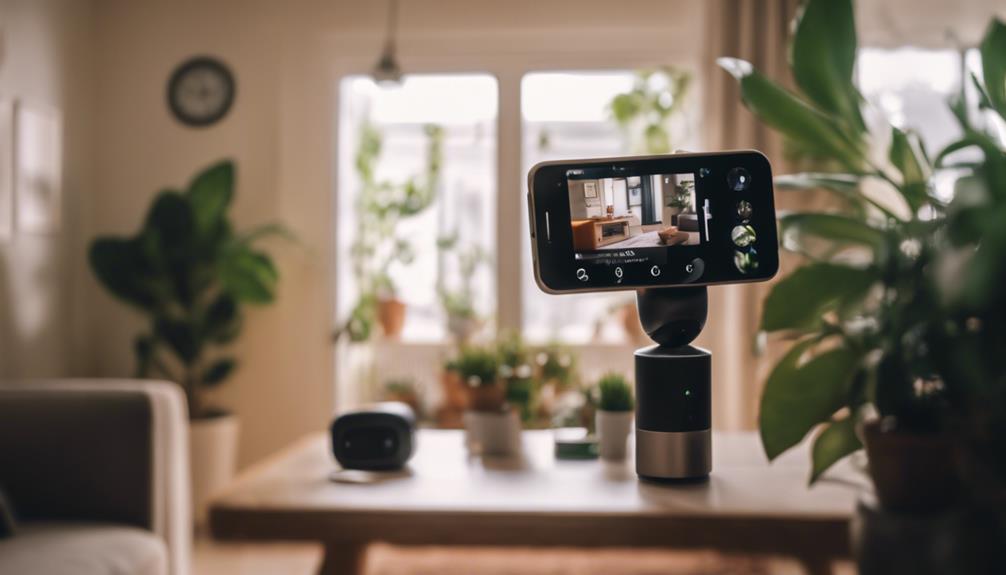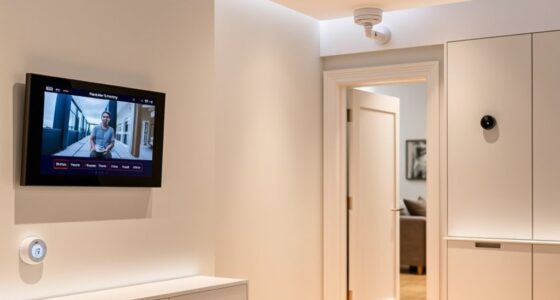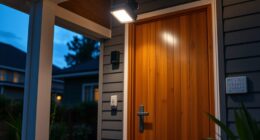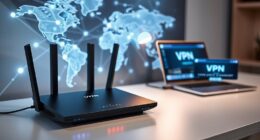To create a home security system, start by evaluating your specific vulnerabilities, like entry points and windows. Choose a DIY system that's easy to install, ensuring it includes cameras and motion sensors. Incorporate essential components, such as smart locks and alarm systems, for enhanced safety. Position cameras for wide coverage and connect everything to your home Wi-Fi for remote access. Don't forget to test the system regularly and update it as needed. With these steps, you're on your way to protecting your home. There's more to explore about enhancing and maintaining your system for ideal security. As you continue to enhance your home security system, consider seeking professional advice or assistance to optimize the home security system installation process. Additionally, research and invest in additional features like glass break sensors and outdoor lighting to further fortify your home’s defenses. By staying diligent and proactive, you can create a comprehensive home security system that provides peace of mind for you and your family.
Key Takeaways
- Assess your home's vulnerabilities and identify high-risk areas for effective placement of security devices like cameras and sensors.
- Choose a DIY home security system that is easy to install and compatible with existing smart home devices for seamless integration.
- Invest in essential components such as 1080p security cameras, smart locks, and alarm systems with mobile alerts and 24/7 monitoring.
- Follow the installation manual carefully, ensuring cameras and sensors are positioned for optimal coverage and connected to your home Wi-Fi.
Assessing Your Security Needs
To effectively secure your home, you need to evaluate your specific security needs by identifying vulnerable areas and reviewing your options.
Start by examining your entry points, such as doors and ground floor windows, since 30% of burglaries happen through unlatched access points. Make certain to check if these areas require additional locks or reinforcements. Additionally, investing in advanced garage door openers can enhance your security by preventing unauthorized access to your home through the garage.
Next, consider the layout of your home. Identify blind spots where burglars might hide and think about where security cameras or sensors could be most effective. This will help guarantee thorough monitoring of your property.
Don't forget about any outbuildings or garages where you store valuable items; these areas may need extra security measures. It's crucial to determine whether you prefer a self-monitoring system or a professional monitoring service, as homes with security systems are three times less likely to be burglarized.
Lastly, analyze your budget. Factor in the initial setup costs and potential ongoing fees for monitoring services, which typically range from $10 to $50 per month, to confirm your security system aligns with your financial capabilities.
Choosing a DIY System

When selecting a DIY home security system, it's essential to evaluate your specific needs and the features that best fit your lifestyle. By understanding what you require, you can make an informed decision about which system might work for you.
Implementing a methodical approach to your selection process will guarantee you take into account all relevant factors, just as successful software quality assurance engineers do when evaluating software products.
Here are some factors to think about when choosing a DIY system:
- Installation Experience: Look for systems that are easy to install and don't require professional assistance.
- Equipment Variety: Make sure the system offers a wide range of sensors and cameras to cover all areas of your home.
- Smart Home Devices: Choose a system compatible with your existing smart home devices for seamless integration.
- Monitoring Options: Evaluate whether you want self-monitoring or professional monitoring services included.
With options like SimpliSafe offering quick setups and abode Smart Security Kit providing tailored solutions, you can find a DIY home security system that suits your preferences.
Be certain to take into account these elements to create a secure environment that aligns with your lifestyle.
Essential Security Components

A well-rounded DIY home security system includes several key components that work together to protect your property effectively.
First, invest in security cameras with at least 1080p resolution for clear video quality. Opt for floodlight cameras for outdoor monitoring and illumination, as they often come with built-in motion sensors. Additionally, consider integrating a heat pump system to maintain a comfortable indoor climate while enhancing overall home security.
Next, incorporate smart locks into your system. These locks provide remote control access and can integrate with other home security devices, offering features like fingerprint and mobile app access. Smart sensors, including motion detectors and door/window sensors, are essential for alerting you to unusual activity. You might also consider environmental sensors to detect smoke and carbon monoxide.
Alarm systems are another critical component. Customize these systems to fit your needs, and look for features like mobile alerts, two-way audio, and a 24/7 monitoring service to enhance your security.
Additionally, verify you have reliable video storage for your security footage, allowing you to review any incidents when necessary. By combining these home security devices, you'll create an all-encompassing system that deters intruders and keeps your home safe.
Camera Options and Features

Choosing the right security camera can greatly enhance your home's safety and provide peace of mind. With various options available, it's crucial to select camera systems that meet your specific needs.
Look for features that improve functionality and effectiveness: modern cameras often incorporate energy-efficient technologies similar to energy-saving ceiling fans that can help reduce your overall energy consumption. Additionally, advanced cameras may provide enhanced video analytics for better monitoring and detection capabilities.
- 1080p resolution for clear video quality
- Night vision capability to monitor in low-light conditions
- Two-way audio for communication with visitors or intruders
- Mobile alerts to keep you informed of suspicious activity in real-time
Outdoor security cameras often come equipped with advanced features like color night vision and motion detection, ensuring thorough coverage.
Models like the Eufy Indoor Cam 2K and Wyze Cam V3 offer flexibility in installation and smart home integration. Additionally, floodlight cameras, such as the Arlo Pro 3 Floodlight Camera, not only illuminate your property but also deter potential intruders with bright LED lights.
Installing Your Security System

When you're ready to install your security system, start by choosing the right components that fit your home's layout.
What to look for in a home cleaning service can also apply to selecting security equipment; make certain that you choose **reputable brands** with good customer reviews.
Follow the installation steps in your user manual, as they'll guide you through the process with ease.
Once everything's set up, don't forget to test your system to make sure it's working effectively before relying on it for your safety.
Choosing Right Components
Selecting the right components for your home security system is essential to ensuring effective protection and ease of use. A well-chosen system not only safeguards your home but also enhances your daily life. For instance, just as understanding cat behavior and emotions can improve your relationship with your pet, selecting the right security components can enhance your peace of mind.
Here are key components to take into account:
- Security Cameras: Look for models with at least 1080p resolution for clear video quality. Choose those compatible with smart home devices for added functionality.
- Smart Locks: Opt for locks that allow remote control and connect with other security devices, giving you convenient access management via your smartphone.
- Video Doorbell: Install one to monitor visitors at your door and receive alerts in real-time.
- Smart Sensors: These detect motion and environmental changes like water leaks, providing extensive home monitoring and alerts for potential hazards.
Make sure the components come with user-friendly installation guides and can be easily integrated into a DIY security system. With the right components, you'll create a reliable and efficient security setup tailored to your needs.
Installation Steps Guide
Start by evaluating your home to pinpoint vulnerable entry points where security devices will provide the best coverage. Look closely at doors, windows, and garages to decide where to install security cameras and motion sensors.
Consider also the air quality in your home, as it can impact your overall well-being; using air purifiers for better health can enhance your living environment.
Choose a DIY security system with essential components like a control panel, door/window sensors, cameras, and an alarm system, making sure it's compatible with your smart devices.
Once you've gathered everything, follow the manufacturer's installation instructions for each component. Most setups require minimal tools and can be completed in 30 minutes to an hour. Position your security cameras for wide coverage, and place motion sensors at the recommended heights to detect movement effectively.
Next, connect your security system to your home Wi-Fi network. This step is vital for enabling remote access via a mobile app, allowing you to receive real-time alerts and manage settings from anywhere.
After everything is installed, take a moment to check that each component is functioning properly, ensuring your home is secure and ready.
Testing and Maintenance Tips
To guarantee your security system operates effectively, regularly test all components and maintain them as needed. This proactive approach not only assures your system is functioning properly but also enhances your overall security coverage.
Here are some essential tips for testing and maintenance:
- Test alarms: Confirm your alarms trigger as expected during testing.
- Check cameras: Review camera positioning and field of view; adjust angles if necessary to eliminate obstructions.
- Inspect sensors: Regularly verify that your sensors detect movement accurately and are free from debris.
- Update software: Review and update your system's firmware to fix vulnerabilities and improve features.
Smart Home Integration

Smart home integration transforms your security system into a cohesive network that automates daily tasks and enhances convenience.
With remote access control, you can monitor and manage your devices from anywhere, giving you peace of mind.
Imagine lights turning on when motion is detected or doors locking automatically at night—this is the power of smart integration.
Automation for Daily Tasks
Integrating automation into your daily tasks not only boosts convenience but also strengthens your home security by allowing devices to work together seamlessly. With smart home products, you can easily set up systems that detect motion, respond to voice commands, and enhance your overall safety.
Here's how you can make the most of automation:
- Schedule Lights: Set your lights to mimic occupancy patterns, deterring potential intruders when you're away.
- Smart Sensors: Use security sensors that trigger automated responses, like turning on lights or sending alerts to your smartphone when unusual activity is detected.
- Smart Door Integration: Connect a smart door that locks or opens based on your preferences or schedules.
- DIY Install: Choose DIY install options for easy setup and integration with existing devices.
Remote Access Control
Remote access control empowers you to monitor and manage your home security system from anywhere, providing peace of mind when you're away. With mobile apps, you can easily check on your property, receive real-time notifications, and respond to alerts instantly. This feature is essential for effective home security management, allowing you to act quickly in case of any incidents.
Many DIY security systems, like SimpliSafe and Ring, offer seamless smart home integration, letting you control your security systems through platforms like Amazon Alexa and Google Assistant. You can manage smart locks, adjust camera settings, and activate or deactivate alarms from your smartphone, enhancing your overall security strategy.
Moreover, smart home integration allows you to automate security routines, such as scheduling indoor lights to mimic your presence or activating cameras when you leave home. This not only adds convenience but also increases your home's safety.
Maintenance and Upkeep

Maintaining your home security system is crucial to guarantee it operates effectively and continues to protect your property. Regular maintenance guarantees that all components—like cameras and motion sensors—function properly, giving you peace of mind.
Here are some essential maintenance tasks to keep your security system in prime condition:
- Test Components: Check your cameras, motion detectors, and alarms at least once a month to confirm they're working correctly.
- Replace Batteries: Change batteries in wireless sensors and cameras every 6 to 12 months to prevent unexpected failures.
- Update Software: Keep your system's software and firmware updated to enhance functionality and protect against vulnerabilities; aim for quarterly checks.
- Adjust Placement: Review camera angles and sensor placements every few months to ensure ideal coverage and eliminate blind spots.
Cost Considerations

When planning a home security system, it's important to evaluate both the initial costs and ongoing expenses to guarantee you choose a solution that fits your budget and needs. Here's a quick overview of key cost considerations:
| Cost Aspect | Estimated Range |
|---|---|
| DIY Home Security Systems | $60 – $400 |
| Monthly Subscription Fees | $10 – $50 |
| Self-Monitoring Options | Free (if self-managed) |
| Setup Costs | Discounts up to 65% |
| Features | Varies by model |
The initial investment for DIY home security systems can range considerably. While some systems are affordable, always consider the features offered to ascertain adequate safety. If you opt for professional monitoring services, expect monthly subscription fees that can add up over time. Alternatively, self-monitoring options allow you to avoid these fees altogether. Don't forget to factor in potential discounts that could lower your setup costs. By weighing these cost considerations carefully, you can create an effective and budget-friendly security solution for your home.
Enhancing Your Security System

Enhancing your home security system involves integrating advanced technology and features that boost protection and convenience. By incorporating various security components, you can create a robust system tailored to your needs. Here are five essential upgrades to take into account:
- High-resolution cameras: Install cameras with at least 1080p resolution for clear monitoring and effective evidence collection.
- Smart locks: Utilize smart locks that support remote access, giving you control over all entry points from anywhere.
- Floodlight cameras: Implement floodlight cameras with motion sensors to illuminate and monitor outdoor areas, deterring intruders.
- Video doorbell: Add a video doorbell to see and communicate with visitors, enhancing your awareness of who's at your door.
Regularly test and maintain all components, ensuring peak performance. With these enhancements, you'll greatly improve your home's security and have peace of mind knowing that you're protected.
Frequently Asked Questions
How Can I Make My Own Home Security?
You can start by evaluating your home's vulnerabilities, then choose security components like cameras and smart locks. DIY systems offer easy installation, and integrating smart technology allows you to monitor everything remotely. Keep it maintained for effectiveness.
How Do You Create a Security System?
Did you know that homes without security systems are 300% more likely to be burglarized? To create a security system, assess vulnerabilities, choose suitable equipment, install essential components, and maintain everything regularly for maximum protection.
Which DIY Home Security System Is Best?
If you're looking for the best DIY home security system, consider the Ring Alarm Kit for its ease of use, or SimpliSafe for affordability. Evaluate your needs to choose the option that suits you best.
Is DIY Home Security Worth It?
Yes, DIY home security's worth it. You save money on installation and monitoring, customize features to fit your needs, and enjoy quick setup. Plus, it considerably reduces your risk of burglary, enhancing your home's safety.
Conclusion
To sum up, creating a home security system tailored to your needs not only protects your castle but also offers peace of mind.
By carefully selecting components and integrating smart technology, you can build a fortress worthy of a modern-day knight.
Remember, regular maintenance is key to ensuring your system remains effective.
With a bit of investment and thoughtful planning, you'll be well on your way to safeguarding your home against any unwanted intruders.
Stay vigilant!









